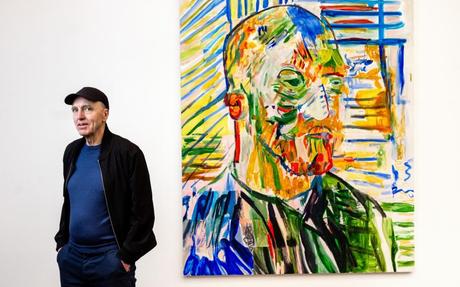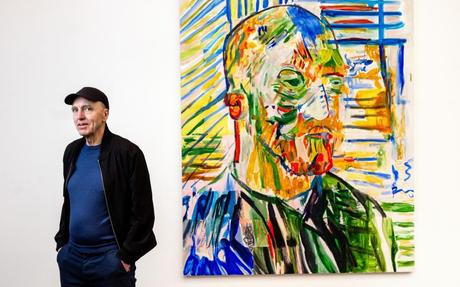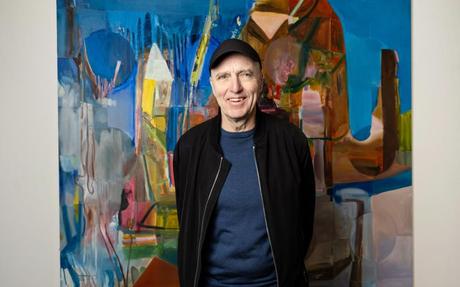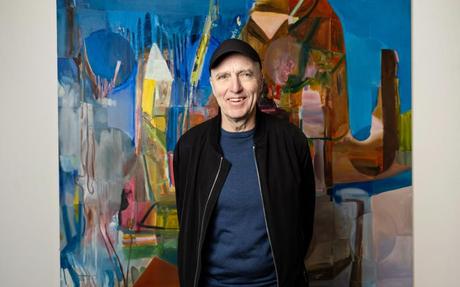Albert Oehlen's canvases may look like they are a noisy pleasure to paint, but that turns out to be far from the case. "I've never felt that before," says the German painter. "Maybe I do that a little now, after all this time, but when I started I felt the opposite: disgust. Even now it is never a pleasure for me to hold the brush."
Oehlen came to prominence in the 1990s, a period when painting seemed to be in decline, despite competition from conceptual, installation and video art. Combining the free-form use of computers and digital printers on an industrial scale with wildly expressive daubing with oil paint, his works felt as if they had experienced the long-predicted 'death of painting' and would come out the other side - a approach described by The New Yorker as 'post-painting'. But for all his pioneering use of computers, Oehlen says he "just hates" the Internet. 'It's dirty. If your life is a building, on which floor is the internet? I think anyone would say it's the basement.'
Oehlen, now 69, is no newcomer to contrarianism. In the 1980s, he was part of a group of punkish "bad boy" artists whose beer- and amphetamine-fueled antics turned the staid German art scene upside down. He and his fellow art conspirators, the painter Werner Büttner and the multimedia prankster Martin Kippenberger - the closest Germany has had to a Damien Hirst - would invade gallery openings and shout out miners' songs.
Kippenberger posed in oversized underwear in tribute to his hero Picasso, who was famously photographed painting in such garments. The trio was seen as rebelling against the high seriousness of much post-war German art - typified by the heavily symbolic imagery of Joseph Beuys and Anselm Kiefer.
Oehlen's deliberately bland 'bad paintings', as he called them, lit up the art market, as a refreshing alternative to the austerity of the then dominant conceptualism and minimalism. (One sold for £6 million at Sotheby's in 2019.)
The story continues


As he approaches 70, does Oehlen still feel like a bad boy? Oehlen cuts a serious, rather shy figure over Zoom from Los Angeles, where he is on vacation with his family, and chuckles dryly at the idea that he could ever have been anything like that. "Some evenings got a little... extended," he says, looking back on those shenanigans. "But the most important things for me were sitting together and talking and exchanging ideas."
There is a mischievous humor beneath Oehlen's seriousness. Now that I've read that in every interview he gives the opposite answer as in his last interview, I'm starting to wonder if I should take everything he says seriously. After all, bluffing is his artistic specialty. "When I started painting as a teenager," he says, "I was very interested in politics, so it seemed obvious that a painting should convey a message. But it only took two or three paintings for me to realize that I didn't believe in representation. So that meant I had to be an abstract painter. But I began to realize that what interested me most were the clichés of abstract painting: the idea that the artist expresses his emotional identity when he puts brush to canvas. I thought, how can I play with these things? How can I mess them up?"
The viewer's perception may be distorted when looking at the paintings in Oehlen's new exhibition at Gagosian, London, in which landscape elements merge with abstract grids and strange mustached faces peer out from swarms of richly colored brushstrokes. Although he has abandoned digital for the time being in favor of pure paint, there is a rather googling randomness to these paintings that is strangely exciting. "People think of art in terms of originality," he says, "but I've always been interested in its artificiality."
Oehlen, the son of a graphic designer from Krefeld, near Düsseldorf, studied at the University of Fine Arts in Hamburg. Growing up in the shadow of the Second World War, he and other artists of his generation - born in the 1950s - were said to have wanted to shake off the weight of history, and the overwhelming sense of guilt evident in the work of many older German artists.
"We were against the self-righteous attitude of some artists," says Oehlen, turning completely serious for a moment. "They approached history in a way that we felt had become bombastic and kitschy. But I didn't want to distance myself from dealing with this history at all. I'm German, and when I learned about 20th century German history at school, it was a shock - for life. Even if you don't see it in my work, it is a project: what can you do after the Holocaust?"
Yet there must have been both pleasure and self-examination in the Berlin scene. Kippenberger's anarchic spirit clearly influenced Oehlen, especially his bad paintings - along with all that beer and speed. He smiles. "I definitely drank beer, but I never needed speed because I already have it in me. But it was 90 percent Kippenberger's show and we went with it." The larger-than-life Kippenberger mocked the idea of the tragic genius, feeling obliged to live up to the archetype by drinking heavily, which contributed to his own death, at the age of 44, in 1997. Oehlen threw himself into his painting and produced a series of deliberately clumsy self-portraits, one of which, Self-Portrait as a Dutch Woman, complimented Kippenberger by claiming that even he could not have painted that badly.


I was surprised to find that the publicity for Oehlen's new exhibition in London revived this idea. Oehlen, we are told, is a proponent of "self-consciously amateurish 'bad' painting, in which spontaneous and expressive gestures are infused with a surreal attitude." I assumed he would have abandoned that attitude in the early 1980s, after 'bad painting', which was briefly a much-discussed - and much-derided - phenomenon, seemed to disappear without a trace.
"The term has always fascinated me," says Oehlen. "Over the years I thought: what happened to that? Because I liked the contradiction of the idea. So I thought maybe I could make more examples of it myself." But is it even possible to make a "bad painting" now? Who would decide what bad painting is, when any sense of a standard in art has become even more diffuse than when Oehlen started making bad paintings in the 1980s?
"Maybe bad painting can mean going against the rules. That's a reason I would sign up for in a heartbeat. We now think that there are no rules in art. But still too many people, artists and audiences believe in it." But what are the rules in art today? "I can't put it into words. But you feel it all the time."
The recent rise of identity-driven art has given rise to a strange kind of conviviality, where if an artist's work meets the right standards, it will be accepted. With this has come a revival of narrative painting, much of it second, and a world away from Oehlen's work. Among the paintings in the Gagosian show are several with discernible trees and sky, inspired by a film he made about Van Gogh, for which he made the paintings - although his approach was not conventional. "When I painted them, I realized that these paintings were completely worthless. So I could ignore the possibility of making 'art'. And that's a happy situation to be in. The work becomes looser and fresher. Some of these paintings are total nonsense. But who cares? They can be the source of a good painting."
'Albert Oehlen: New Paintings' is on display at Gagosian Grosvenor Hill, London W1 until May 11. Info: gagosian.com